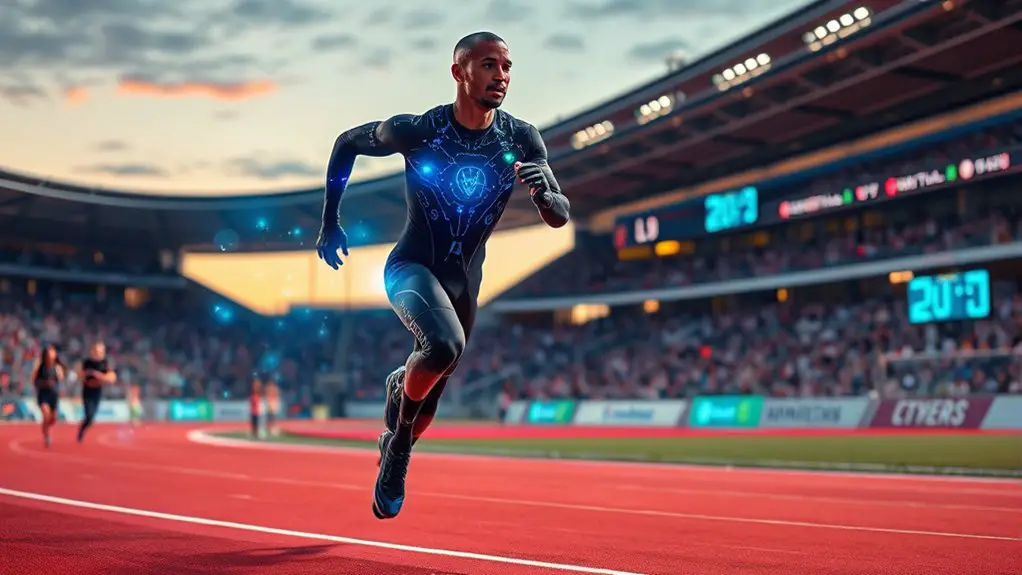The future of biometric tracking in sports is all about advanced wearables that enhance performance analysis and injury prevention. You'll benefit from real-time insights into your training, recovery, and biomechanics. These sleek devices provide personalized data that helps you optimize your strategies and avoid overtraining. As AI and technology continue to evolve, your athletic potential will be redefined. Stick around to discover how these innovations could shape the next era of sports performance.
The Evolution of Biometric Tracking Technology
As technology has advanced, biometric tracking in sports has evolved from basic measurements to sophisticated systems that provide real-time data. You might remember a time when athletes relied on simple stopwatches and heart rate monitors. Now, wearable devices track everything from your heart rate to your sleep patterns, giving you insights into your performance like never before. These innovations empower you, allowing you to take charge of your training and recovery.
Imagine wearing a sleek device that not only monitors your essentials but also analyzes your biomechanics, helping you refine your techniques. This evolution isn't just about numbers; it's about enhancing your freedom to push boundaries. With data at your fingertips, you can make informed choices tailored to your body's needs. AI-driven personalized recovery programs are revolutionizing how you understand your capabilities, leading to a more personalized and liberated approach to sports. Embrace this technology and release your true potential!
Key Benefits for Athletes and Coaches
The advancements in biometric tracking technology bring significant benefits for both athletes and coaches. You'll find that real-time data helps you optimize performance and make informed decisions. With wearable devices monitoring your heart rate, stress levels, and sleep patterns, you can identify what works best for your body and adjust your training accordingly.
For coaches, this technology offers insights that shape training strategies and enhance team dynamics. You'll have the ability to pinpoint strengths and weaknesses, enabling targeted coaching that empowers athletes to reach their potential.
Moreover, understanding your physiological responses can help you prevent injuries, giving you the freedom to push your limits without fear. This data-driven approach not only fosters a culture of accountability but also cultivates a deeper connection between you and your sport. Embracing biometric tracking can truly revolutionize how you train and compete, leading to a more fulfilling athletic experience. Additionally, integrating biofeedback techniques can further enhance your mental conditioning, allowing for improved focus and stress management during competitions.
Enhancing Training Regimens With Data Analytics
With biometric tracking, you can monitor your performance in real-time, giving you immediate feedback on your training. By using data analytics, you can create personalized training plans that cater specifically to your strengths and weaknesses. Plus, these insights can help prevent injuries, keeping you in the game longer and at your best. Additionally, real-time heart rate monitoring allows you to optimize your workouts and make informed training decisions.
Real-time Performance Monitoring
While athletes aim for peak performance, real-time performance monitoring has emerged as a game-changer in training regimens. This technology allows you to track your metrics instantly, enabling you to make quick adjustments. Imagine pushing your limits while data guides you, ensuring you maximize every drop of sweat.
| Metric | Real-Time Data | Impact on Performance |
|---|---|---|
| Heart Rate | 150 bpm | Optimize endurance |
| Speed | 25 km/h | Enhance agility |
| Power Output | 300 watts | Boost strength |
| Recovery Time | 30 minutes | Prevent injuries |
| Calories Burned | 600 kcal | Improve fitness |
With insights at your fingertips, you can refine your skills freely, paving the way to extraordinary achievements.
Personalized Training Plans
As you endeavor to elevate your performance, personalized training plans powered by data analytics can make all the difference. By harnessing your unique data, you can craft a regimen that truly resonates with your goals. Imagine:
- Tailored Workouts: Get exercises specifically designed for your strengths and weaknesses, empowering you to push your limits.
- Optimized Recovery: Discover the ideal rest periods and recovery techniques to keep you feeling fresh and ready to conquer.
- Progress Tracking: Monitor your advancements in real-time, allowing you to adjust and refine your plan as needed.
With these insights, you'll find yourself training smarter, not just harder. Embrace the freedom of a personalized plan, and watch your performance soar to new heights!
Injury Prevention Insights
Injury prevention is a crucial aspect of any athletic journey, and leveraging data analytics can considerably enhance your training regimen. By tracking your movements, workload, and recovery metrics, you can identify patterns that lead to injuries. This insight allows you to adjust your training intensity, ensuring you're pushing limits without overdoing it.
With wearable technology and biometric data, you'll gain real-time feedback on your performance and fatigue levels, helping you make informed decisions. Instead of relying solely on intuition, you can embrace a data-driven approach that prioritizes your health and longevity in the sport. Ultimately, using analytics not only keeps you on the field but also empowers you to train smarter, giving you the freedom to pursue your athletic goals without fear of setbacks.
Injury Prevention and Recovery Monitoring
When athletes incorporate biometric tracking into their training regimens, they can greatly enhance injury prevention and recovery monitoring. By understanding their bodies in real-time, you'll find freedom in movement and performance, reducing the risk of setbacks. Here are three ways biometric tracking can help you:
- Movement Analysis: Obtain precise data on your biomechanics, pinpointing any imbalances that could lead to injuries.
- Load Monitoring: Keep track of your training intensity and volume, ensuring you don't overdo it and push your body too far.
- Recovery Insights: Measure physiological markers like heart rate variability, helping you gauge when it's time to rest or when you're ready to push harder.
Additionally, utilizing Functional Movement Screening can further enhance your understanding of movement patterns, allowing for more tailored training approaches. With this knowledge, you can take control of your training, allowing your body to thrive while minimizing the risks of injury. Embrace this technology, and enjoy the freedom it brings to your athletic journey!
The Role of Wearable Devices in Sports
Wearable devices are revolutionizing how you monitor athletic performance and track your health. With real-time data, you can gain insights into your strengths and weaknesses, helping to enhance your training. Plus, these devices can provide valuable information for injury prevention, ensuring you stay in peak condition. Many of these devices also feature accurate heart rate monitoring, enabling you to gauge your exertion levels during workouts effectively.
Enhanced Performance Monitoring
As athletes endeavor to reach peak performance, the integration of advanced wearable devices has become essential in monitoring their progress and well-being. These devices not only track your physical metrics but also empower you to make informed decisions about your training. Imagine having access to:
- Real-time heart rate data – keeping you in the ideal zone during workouts.
- GPS tracking – allowing you to explore new routes while ensuring you stay on track.
- Sleep quality analysis – helping you understand how rest impacts your performance.
With these tools at your fingertips, you can break free from limitations and push your boundaries. Embracing this technology paves the way for personalized training, enhancing your overall athletic journey.
Injury Prevention Insights
Injuries can sideline even the most dedicated athletes, but with the right technology, you can greatly reduce that risk. Wearable devices provide real-time data, helping you identify potential injury risks before they become serious problems. By tracking metrics like heart rate, fatigue levels, and movement patterns, you can adjust your training accordingly.
Here's a quick look at how wearable tech can help:
| Metric | Purpose | Benefit |
|---|---|---|
| Heart Rate | Monitor exertion levels | Prevent overtraining |
| Movement Patterns | Analyze biomechanics | Reduce injury risk |
| Fatigue Levels | Gauge recovery needs | Optimize training schedules |
Embracing this technology empowers you to stay active and injury-free, allowing you to pursue your passion for sports with freedom.
Challenges and Limitations of Biometric Tracking
While biometric tracking offers valuable insights into athletes' performance, several challenges and limitations can hinder its effectiveness. You might find that these obstacles can impact your training and overall experience:
- Data Overload: With so much information at your fingertips, it can be overwhelming to sift through metrics, making it hard to focus on what truly matters.
- Accuracy Issues: Not all devices are created equal. Some may deliver inconsistent readings, leading you to make decisions based on faulty data.
- Privacy Concerns: You might feel uneasy about sharing your biometric data, wondering who has access and how it's being used, which can create a sense of unease. Additionally, the use of recovery technology can sometimes lead to an over-reliance on data, further complicating your training approach.
Navigating these challenges is essential for maximizing the benefits of biometric tracking while maintaining your freedom as an athlete. A balanced approach can help you harness the power of technology without compromising your autonomy.
Ethical Considerations in Data Collection and Usage
When it comes to biometric data collection, ethical considerations are essential for ensuring that athletes' rights and privacy are respected. You've got to ask yourself: who owns the data? Athletes should have control over their personal information, including how it's collected and used. Transparency in data practices is critical, so athletes understand what's at stake.
Informed consent is another key aspect; you can't just collect data without athletes knowing what they're signing up for. There's also the risk of misuse—data can be exploited for commercial gain or even used against athletes in ways they never intended.
Creating an environment of trust is important. If athletes feel their data is safeguarded, they'll be more likely to engage in biometric tracking. Ultimately, respecting their autonomy and promoting ethical practices will foster a healthier relationship between technology and sports, allowing athletes to thrive without compromising their freedom.
The Future Landscape of Biometric Tracking in Sports
As technology continues to advance, you can expect biometric tracking in sports to evolve considerably, shaping the way athletes train and compete. Imagine a world where each athlete's performance is fine-tuned by real-time data, enabling them to reach their peak potential. Here's what the future might hold:
- Wearable Devices: Sleek, unobtrusive gadgets that monitor heart rate, hydration levels, and fatigue, providing instant feedback.
- AI Analytics: Intelligent algorithms analyzing performance patterns, offering personalized training regimens that adapt as you progress.
- Virtual Reality Integration: Immersive training environments that simulate competitive scenarios, allowing you to practice under real-world conditions.
Furthermore, these innovations will empower athletes to leverage real-time analytics to make informed decisions that enhance their performance. With these advancements, you'll have the freedom to push your limits, optimize your training, and redefine what's possible in your sport. The landscape of biometric tracking is not just about numbers; it's about revealing your true potential.
Frequently Asked Questions
How Accurate Are Current Biometric Tracking Devices in Real-Time Performance Monitoring?
Current biometric tracking devices vary in accuracy, but many can provide real-time performance data within a few percentage points. You'll find they're quite reliable for tracking heart rate, movement, and overall performance during activities.
What Sports Benefit the Most From Biometric Tracking Technology?
You'd think all sports would thrive on biometric tracking, right? Yet, sports like running, cycling, and swimming truly excel, as athletes harness data to push limits and reclaim their freedom. Who knew numbers could be so liberating?
Can Biometric Data Be Integrated With Mental Performance Analytics?
Yes, you can integrate biometric data with mental performance analytics. By combining physical metrics with psychological insights, you'll gain a more thorough view of an athlete's overall performance, helping them enhance both mind and body efficiency.
How Is Biometric Data Stored and Protected From Unauthorized Access?
Imagine a fitness app tracking your heart rate. Biometric data's stored using encryption and secure servers, ensuring unauthorized access isn't possible. Always check privacy policies; you're entitled to know how your personal data's protected.
What Is the Cost Range for Implementing Biometric Tracking in Sports Teams?
Implementing biometric tracking in sports teams can cost anywhere from a few thousand to several hundred thousand dollars, depending on the technology and integration complexity. You'll want to weigh benefits against your budget and needs.



